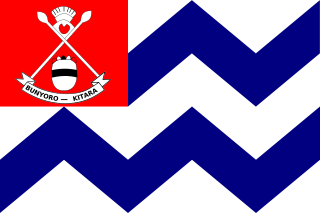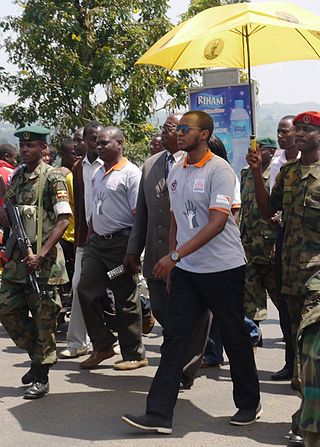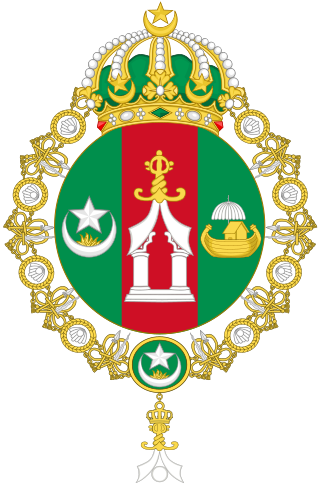The honorific prefix "The Most Honourable" is a form of address that is used in several countries. In the United Kingdom, it precedes the name of a marquess or marchioness.

A coronet is a small crown consisting of ornaments fixed on a metal ring. A coronet differs from other kinds of crowns in that most coronets do not have arches, and from a tiara in that a coronet completely encircles the head, while a tiara does not.

Bunyoro or Bunyoro-Kitara is a Bantu kingdom in Western Uganda. It was one of the most powerful kingdoms in Central and East Africa from the 13th century to the 19th century. It is ruled by the King (Omukama) of Bunyoro-Kitara. The current ruler is Solomon Iguru I, the 27th Omukama.

Ankole was a traditional Bantu kingdom in Uganda and lasted from the 15th century until 1967. The kingdom was located in south-western Uganda, east of Lake Edward.
Omukama wa Bunyoro Translates to The King of Bunyoro is the title given to rulers of the East African kingdom of Bunyoro-Kitara. The kingdom lasted as an independent state from the 16th to the 19th century. The Omukama of Bunyoro remains an important figure in Ugandan politics, especially among the Banyoro people of whom he is the titular head. He is closely related to the Omukama of Toro Kingdom.

Busoga is a kingdom and one of four constitutional monarchies in present-day Uganda. The kingdom is a cultural institution which promotes popular participation and unity among the people of the region through development programs to improve their standard of living. Busoga strives for a united people who have economic, social and cultural prosperity and assists the Kyabazinga.

Due to the differing role of women in past society, special rules grew relating to the blazoning of arms for women. The rules for women and heraldry developed differently from place to place and there is no one single rule that applies everywhere. In general, arms of women were most likely depicted not on shields but on lozenges or ovals. Different rules exist that depend on the woman's marital status and a married woman would also often make use of her husband's arms in addition to those from her family. In both the English and the Scottish systems of heraldry these differences remain active.

The Nyoro or Banyoro are a Bantu ethnic group native to the kingdom of Bunyoro in Uganda. They live in settlements on a well-watered and fertile plateau. Banyoro are closely related to other Bantu peoples of the region, namely the Batoro, Banyankole, Bakiga and the Bahema peoples.

Rukirabasaija Omukama Oyo Nyimba Kabamba Iguru Rukidi IV, King Oyo, is the reigning Omukama of Tooro, in Uganda. He was born on 16 April 1992 to King Patrick David Mathew Kaboyo Olimi III and Queen Best Kemigisa Kaboyo. Three and half years later in 1995, Oyo ascended the throne and succeeded his father to become the 12th ruler of the 180-year-old Kingdom of Tooro.

A crown is often an emblem of a sovereign state, usually a monarchy, but also used by some republics.
Chwa II Kabalega, was the King or Omukama of Bunyoro in Uganda from 1870 to 1899.

Canadian heraldry is the cultural tradition and style of coats of arms and other heraldic achievements in both modern and historic Canada. It includes national, provincial, and civic arms, noble and personal arms, ecclesiastical heraldry, heraldic displays as corporate logos, and Canadian blazonry.
Omukama Rukirabasaija Agutamba Solomon Gafabusa Iguru I is the 27th Omukama of Bunyoro from 1994 to present. The King's traditional alternative name used by family is Amooti.

The Medal of Honor of the Association of the Representatives of Bunyoro-Kitara (ARKBK) is the highest award of the organization, and can only be awarded by the President of the ARKBK. It is bestowed upon members of the ARKBK or to individuals who have distinguished themselves with "extraordinary merits, outstanding achievements and very special contributions to the Kingdom of Bunyoro-Kitara and the ARKBK".

The Royal Order of the Omujwaara Kondo is the oldest and highest royal order of the Bunyoro-Kitara Kingdom and is awarded solely by the Omukama (King) of Bunyoro. It is a single-grade honour, separated into two classes - Class I and Class II. Class I is limited to other royal families of the world and heads of state, while Class II is open to all persons.

The Association of Representatives of the Bunyoro-Kitara Kingdom CLBG(ARKBK) is a non-profit charity and NGO in the West-Ugandan kingdom of Bunyoro-Kitara. It was established by royal charter on August 27, 2009 by Omukama ("King") Solomon Iguru I and is incorporated under the Ugandan Companies Act. Its purpose is to promote the Kingdom internationally and to support development programs for the region. The organisation aims to remain neutral in regards to political and religious matters.

The Royal and Hashemite Order of the Pearl is the dynastic order of the Royal House of Sulu, which serves as the premier institution and the highest personal honour of and in the Royal Sultanate of Sulu. The order is an honourable and nobiliary corporation instituted as a dynastic Order of Datuship analogous to traditional dynastic orders of chivalry, and is in direct continuation from the ancient customs and distinctions of the Royal Sultanate of Sulu and the Court of the Sultan. Ampun Sultan Muedzul Lail Tan Kiram, as Head of the Royal House of Sulu, is the hereditary sovereign who processes the fons honorum and Grand Sayyid of the order, and his heirs and successors as heads of the Royal House of Sulu, shall ever be sovereigns and Grand Sayyids of the order.
The Ugandan honours system consists of orders and medals awarded for exemplary service to the nation.
The Most Honourable Order of Omukama Chwa II Kabalega is the third highest royal order of merit of the Kingdom of Bunyoro, and is awarded solely by the Omukama of Bunyoro. It is named in honour of Omukama (King) Chwa II Kabalega of Bunyoro, who is famous for resisting colonialism during his reign.

The coat of arms of the Prince of Wales is the official heraldic insignia of the Prince of Wales, a title traditionally granted to the heir apparent of the reigning monarch of the United Kingdom of Great Britain and Northern Ireland, formerly the Kingdom of Great Britain and before that the Kingdom of England.
















